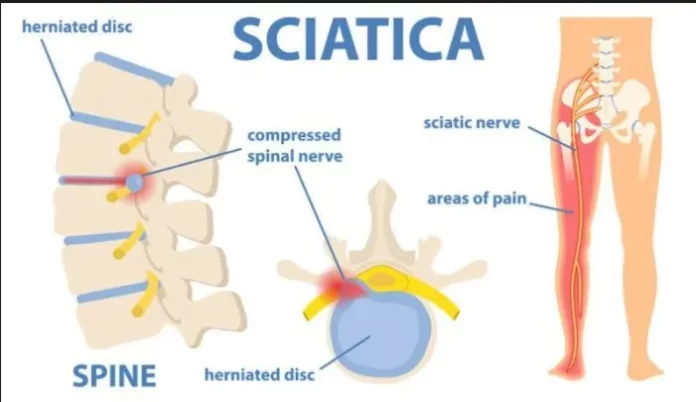Estimated reading time: 0 minutes
The kind and intensity of the underlying illness usually determines the length of sciatica. While sciatica usually resolves in a few weeks, certain medical conditions can cause your symptoms to last up to two years.
Continue reading to learn about the most common causes of sciatica, when your symptoms could develop, and common treatments and advice to help prevent your back and leg pain from recurring or worsening.
When acute sciatica develops into chronic sciatica
A common source of sciatica is a lower back condition that irritates or inflames a sciatic nerve root, such as:
- Disc herniation in the lower back
- Lumbar stenosis is a type of spinal stenosis.
- Lumbar spine degenerative disc disease
- Spondylolisthesis
- Muscular spasms and/or inflammation in the lower back and/or pelvis
If you have a recent lower back trouble, you will have acute sciatica, which can flare up irregularly or continuously for up to 4 to 6 weeks before going away on its own.
If left untreated or if the underlying reason is severe, sciatica can become chronic and persistent, lasting two months or longer. 3 Sciatica will affect 20% to 30% of persons for the next year or two.
Sciatica therapy at home
Everyone is affected differently by sciatica. Several nerve roots may be injured in sciatica, each causing pain and/or numbness in a different part of your thigh, leg, and/or foot. The response to a single medication may also differ between people with the same sciatica diagnosis. Finding the right treatment is typically a process of trial and error.
Combine the following remedies for efficient sciatica pain relief at home:
Baths in ice. If you have acute sciatica, try putting an ice pack on your back pelvis. Ice therapy improves lower back pain nearly instantaneously by constricting blood vessels, slowing blood flow, and decreasing inflammation. 4 and 5 are pain relievers. Try topical pain treatments or over-the-counter oral medications like NSAIDs (Non-Steroidal Anti-Inflammatory Drugs). While oral medications build in the body and have a broad effect, topical therapies may work faster due to their targeted action.
The application of heat therapy. Heat therapy, by relaxing tight muscles and increasing blood flow, may help reduce persistent sciatica pain. These effects may also help your lower back tissues repair.
Massage. Massage your lower back gently to release endorphins (your body’s natural feel-good hormone) and reduce muscle tension. Massage can relieve pain temporarily but effectively while also encouraging the body’s natural healing processes.
When sitting, standing, lifting, and walking, it is also vital to use ergonomically safe and supported postures.
Home exercises to relieve sciatica
Regular exercise can help relieve acute sciatica pain and prevent future flare-ups. Exercises that you can do at home can be taught to you by physical therapists.
Before beginning any workout programme, consult with a qualified health practitioner to discover the cause of your sciatica. Exercises for sciatica caused by a herniated disc differ substantially from those for symptoms caused by spinal stenosis, and if performed incorrectly, each type of exercise may worsen or aggravate the underlying cause.
Allopathic treatment for sciatica
Typically, the recommended treatment will include a combination of the following:
Sciatica pain relievers on prescription
Physical therapy and exercise
Hand manipulation
Steroid injections into the lumbar epidural space
While surgery is unusual, it may be indicated for chronic sciatica that has not responded to nonsurgical treatment after many weeks.
Sciatica Ayurvedic Treatment
Ayurvedic sciatica treatment focuses on removing the underlying cause of the problem. The treatment consists of a combination of physical therapy to reduce pain and inflammation; Ayurvedic herbs and medications to balance doshas and treat sciatica; and rasayana therapy (rejuvenation therapy) to maintain the body’s natural power and vitality. Massage treatment is also offered to persons with sciatica to help with blood circulation, muscle relaxation, and the release of hormones that function as pain relievers. This method of treatment aids in the natural reversal of sciatica symptoms.
Related-
Know more about Ayurvedic Spinal Disk & Radiculopathy Treatments.
GET IN TOUCH


Recent comments